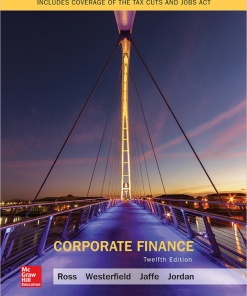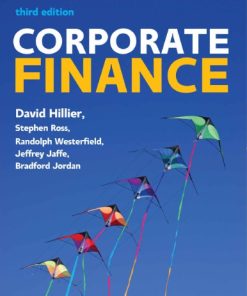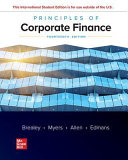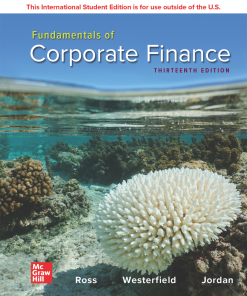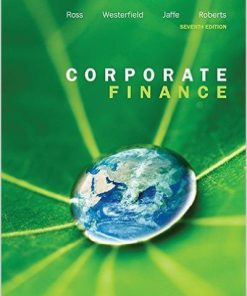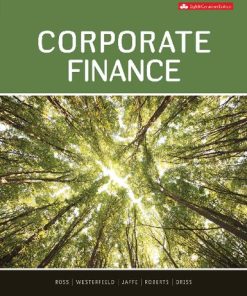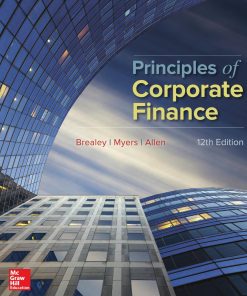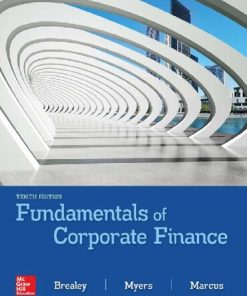(Ebook PDF) Corporate Finance 13th Edition by Bradford Jordan, Jeffrey Jaffe, Randolph Westerfield, Stephen Ross 1264112181 9781264112180 full chapters
$50.00 Original price was: $50.00.$25.00Current price is: $25.00.
Corporate Finance 13th Edition by Bradford Jordan, Jeffrey Jaffe, Randolph Westerfield, Stephen Ross – Ebook PDF Instant Download/DeliveryISBN: 1264112181, 9781264112180
Full download Corporate Finance 13th Edition after payment.
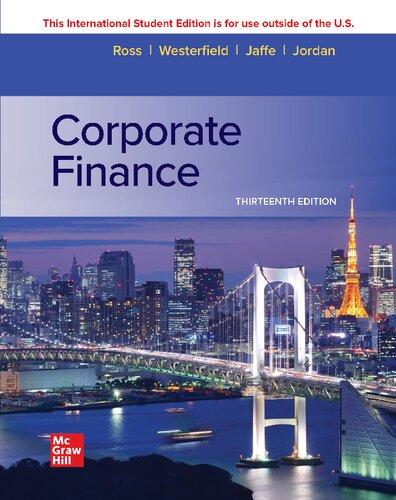
Product details:
ISBN-10 : 1264112181
ISBN-13 : 9781264112180
Author: Bradford Jordan, Jeffrey Jaffe, Randolph Westerfield, Stephen Ross
Corporate Finance, by Ross, Westerfield, Jaffe, and Jordan, was written for the corporate finance course at the MBA level and the intermediate course in many undergraduate programs. The text emphasizes the modern fundamentals of the theory of finance while providing contemporary examples to make the theory come to life. The authors aim to present corporate finance as the working of a small number of integrated and powerful intuitions rather than a collection of unrelated topics. They develop the central concepts of modern finance: arbitrage, net present value, efficient markets, agency theory, options, and the trade-off between risk and return, and use them to explain corporate finance with a balance of theory and application. The 13th edition also welcomes a special contributor, Professor Kelly Shue of Yale University.
Corporate Finance 13th Table of contents:
Chapter 1: Introduction to Corporate Finance
Chapter 1 Introduction
Introduction to Corporate Finance
1.1 What Is Corporate Finance?
The Balance Sheet Model of the Firm
The Financial Manager
1.2 The Corporate Firm
The Sole Proprietorship
The Partnership
The Corporation
A Corporation by Another Name . . .
1.3 The Importance of Cash Flows
Identification of Cash Flows
Timing of Cash Flows
Risk of Cash Flows
1.4 The Goal of Financial Management
Possible Goals
The Goal of The Financial Manager
A More General Goal
1.5 The Agency Problem and Control of the Corporation
Agency Relationships
Management Goals
Do Managers Act in the Stockholders’ Interests?
Stakeholders
1.6 Regulation
The Securities Act of 1933 and the Securities Exchange Act of 1934
Sarbanes-Oxley
Summary and Conclusions
Concept Questions
Chapter 2: Financial Statements and Cash Flow
Chapter 2 Introduction
2.1 The Balance Sheet
Liquidity
Debt versus Equity
Value versus Cost
2.2 The Income Statement
Generally Accepted Accounting Principles
Noncash Items
Time and Costs
2.3 Taxes
Corporate and personal Tax Rates
Average versus Marginal Tax Rates
2.4 Net Working Capital
2.5 Cash Flow of the Firm
2.6 The Accounting Statement of Cash Flows
Cash Flow from Operating Activities
Cash Flow from Investing Activities
Cash Flow from Financing Activities
2.7 Cash Flow Management
Summary and Conclusions
Concept Questions
Questions and Problems
Excel Master It! Problem
Mini Case
Chapter 3: Financial Statements Analysis and Financial Models
Chapter 3 introduction
3.1 Financial Statements Analysis
Standardizing Statements
Common-Size Balance Sheets
Common-Size Income Statements
3.2 Ratio Analysis
Short-Term Solvency or Liquidity MEASURES
Long-Term Solvency Measures
Asset Management or Turnover Measures
Profitability Measures
Market Value Measures
3.3 The DuPont Identity
A Closer Look at ROE
Problems with Financial Statement Analysis
3.4 Financial Models
A Simple Financial Planning Model
The Percentage of Sales Approach
3.5 External Financing and Growth
THE RELATIONSHIP BETWEEN EFN and Growth
Financial Policy and Growth
A Note about Sustainable Growth Rate Calculations
3.6 Some Caveats Regarding Financial Planning Models
Summary and Conclusions
Concept Questions
Questions and Problems
Excel Master It! Problem
Mini Case
Chapter 4: Discounted Cash Flow Valuation
Chapter 4 Introduction
Discounted Cash Flow Valuation
4.1 Valuation: The One-Period Case
4.2 The Multiperiod Case
Future Value and Compounding
The Power of Compounding: A Digression
Present Value and Discounting
Finding the Number of Periods
The Algebraic Formula
4.3 Compounding Periods
Distinction between ANNUAL PERCENTAGE RATE and Effective Annual Rate
Compounding over Many Years
Continuous Compounding
4.4 Simplifications
Perpetuity
Growing Perpetuity
Annuity
Growing Annuity
4.5 Loan Amortization
4.6 What Is a Firm Worth?
Summary and Conclusions
Concept Questions
Questions and Problems
Excel Master It! Problem
Mini Case
Appendix 4A and 4B
Appendix 4A
Appendix 4B
Chapter 5: Net Present Value and Other Investment Rules
Chapter 5 Introduction
5.1 Why Use Net Present Value?
5.2 The Payback Period Method
Defining the Rule
Problems with the Payback Method
Managerial Perspective
Summary of Payback
5.3 The Discounted Payback Period Method
5.4 The Internal Rate of Return
5.5 Problems with the IRR Approach
Definition of Independent and Mutually Exclusive Projects
Two General Problems Affecting Both Independent and Mutually Exclusive Projects
The Modified Internal Rate of Return (MIRR)
Problems Specific to Mutually Exclusive Projects
Redeeming Qualities of IRR
A Test
5.6 The Profitability Index
Calculation of Profitability Index
5.7 The Practice of Capital Budgeting
Summary and Conclusions
Concept Questions
Questions and Problems
Excel Master It! Problem
Mini Case
Chapter 6: Making Capital Investment Decisions
Chapter 6 Introduction
6.1 Incremental Cash Flows: The Key to Capital Budgeting
Cash Flows—Not Accounting Income
Sunk Costs
Opportunity Costs
Side Effects
Allocated Costs
6.2 The Baldwin Company: An Example
An Analysis of the Project
Which Set of Books?
A Note about Net Working Capital
A Note about Depreciation
financing costs
6.3 Alternative Definitions of Operating Cash Flow
The Top-Down Approach
The Bottom-Up Approach
The Tax Shield Approach
Conclusion
6.4 Some Special Cases of Discounted Cash Flow Analysis
Evaluating Cost-Cutting Proposals
SETTING THE BID PRICE
Investments of Unequal Lives: The Equivalent Annual Cost Method
6.5 Inflation and Capital Budgeting
Interest Rates and Inflation
Cash Flow and Inflation
Discounting: Nominal or Real?
Summary and Conclusions
Concept Questions
Questions and Problems
Excel Master It! Problems
Mini Cases
Chapter 7: Risk Analysis, Real Options, and Capital Budgeting
Chapter 7 Introduction
7.1 Sensitivity Analysis, Scenario Analysis, and Break-Even Analysis
Sensitivity Analysis and Scenario Analysis
Break-Even Analysis
7.2 Monte Carlo Simulation
Step 1: Specify the Basic Model
Step 2: Specify a Distribution for Each Variable in the Model
Step 3: The Computer Draws One Outcome
Step 4: Repeat the Procedure
Step 5: Calculate NPV
7.3 Real Options
The Option to Expand
The Option to Abandon
Timing Options
7.4 Decision Trees
Summary and Conclusions
Concept Questions
Questions and Problems
Excel Master It! Problem
Mini Case
Chapter 8 Interest Rates and Bond Valuation
Chapter 8 Introduction
8.1 Bonds and Bond Valuation
Bond Features and Prices
Bond Values and Yields
Interest Rate Risk
Finding the Yield to Maturity: More Trial and Error
Zero Coupon Bonds
8.2 Government and Corporate Bonds
Government Bonds
Corporate Bonds
Bond Ratings
8.3 Bond Markets
How Bonds Are Bought and Sold
Bond Price Reporting
A Note on Bond Price Quotes
8.4 Inflation and Interest Rates
Real versus Nominal Rates
Inflation Risk and Inflation-Linked Bonds
The Fisher Effect
8.5 Determinants of Bond Yields
The Term Structure of Interest Rates
Bond Yields and the Yield Curve: Putting It All Together
Conclusion
Summary and Conclusions
Concept Questions
Questions and Problems
Excel Master It! Problem
Mini Case
Chapter 9: Stock Valuation
Chapter 9 Introduction
9.1 The Present Value of Common Stocks
Dividends versus Capital Gains
Valuation of Different Types of Stocks
9.2 Estimates of Parameters in the Dividend Discount Model
Where Does g Come From?
Where Does R Come From?
A Healthy Sense of Skepticism
Dividends or Earnings: Which to Discount?
The No-Dividend Firm
9.3 Comparables
Price-Earnings Ratio
Enterprise Value Ratios
9.4 Valuing Stocks Using Free Cash Flows
9.5 The Stock Markets
Dealers and Brokers
Organization of the NYSE
TYPES OF ORDERS
NASDAQ Operations
Stock Market Reporting
Summary and Conclusions
Concept Questions
Questions and Problems
Excel Master It! Problem
Mini Case
Chapter 10: Lessons from Market History
Chapter 10 Introduction
Lessons from Market History
10.1 Returns
Dollar Returns
Percentage Returns
10.2 Holding Period Returns
10.3 Return Statistics
10.4 Average Stock Returns and Risk-Free Returns
10.5 Risk Statistics
Variance
Normal Distribution and Its Implications for Standard Deviation
10.6 More on Average Returns
Arithmetic versus Geometric Averages
Calculating Geometric Average Returns
Arithmetic Average Return or Geometric Average Return?
10.7 The U.S. Equity Risk Premium: Historical and International Perspectives
10.8 2008: A Year of Financial Crisis
Summary and Conclusions
Concept Questions
Questions and Problems
Excel Master It! Problem
Mini Case
Chapter 11: Return, Risk, and the Capital Asset Pricing Model
Chapter 11 Introduction
11.1 Individual Securities
11.2 Expected Return, Variance, and Covariance
Expected Return and Variance
Covariance and Correlation
11.3 The Return and Risk for Portfolios
The Expected Return on a Portfolio
Variance and Standard Deviation of a Portfolio
11.4 The Efficient Set for Two Assets
11.5 The Efficient Set for Many Securities
Variance and Standard Deviation in a Portfolio of Many Assets
11.6 Diversification
The Anticipated and Unanticipated Components of News
Risk: Systematic and Unsystematic
The Essence of Diversification
The Effect of Diversification: Another Lesson from Market History
11.7 Riskless Borrowing and Lending
The Optimal Portfolio
11.8 Market Equilibrium
Definition of the Market Equilibrium Portfolio
Definition of Risk When Investors Hold the Market Portfolio
The Formula for Beta
A Test
11.9 Relationship between Risk and Expected Return (CAPM)
Expected Return on THE Market
Expected Return on AN Individual Security
Summary and Conclusions
Concept Questions
Questions and Problems
Excel Master It! Problem
Mini Case
Appendix 11A
Appendix 11A
Chapter 12: An Alternative View of Risk and Return
Chapter 12 Introduction
THE ARBITRAGE PRICING THEORY
12.1 Systematic Risk and Betas
12.2 Portfolios and Factor Models
Portfolios and Diversification
12.3 Betas, Arbitrage, and Expected Returns
The Linear Relationship
The Market Portfolio and the Single Factor
12.4 The Capital Asset Pricing Model and the Arbitrage Pricing Theory
Differences in Pedagogy
Differences in Application
12.5 Empirical Approaches to Asset Pricing
Empirical Models
Style Portfolios
Summary and Conclusions
Concept Questions
Questions and Problems
Excel Master It! Problem
Mini Case
Chapter 13: Risk, Cost of Capital, and Valuation
Chapter 13 Introduction
13.1 The Cost of Capital
13.2 Estimating the Cost of Equity Capital with the CAPM
The Risk-Free Rate
Market Risk Premium
13.3 Estimation of Beta
Real-World Betas
Stability of Beta
13.4 Determinants of Beta
Cyclicality of Revenues
Operating Leverage
Financial Leverage and Beta
Beta in a world with taxes
13.5 The Dividend Discount Model Approach
Comparison of DDM and CAPM
13.6 Cost of Capital for Projects
The Comparables Method
Using Industry Comparables
13.7 Cost of Fixed Income Securities
Cost of Debt
Cost of Preferred Stock
13.8 The Weighted Average Cost of Capital
Cost of Levered Equity
Financing with a mix of debt and equity
Applying the WACC
13.9 Valuation with WACC
Valuing a Finite-Horizon Project
Terminal Value and the WACC
13.10 Estimating Eastman Chemical’s Cost of Capital
13.11 Flotation Costs and the Weighted Average Cost of Capital
The Basic Approach
Flotation Costs and NPV
Internal Equity and Flotation Costs
Summary and Conclusions
Concept Questions
Questions and Problems
Excel Master It! Problem
Mini Case
Appendix 13A
Appendix 13A
Chapter 14: Efficient Capital Markets and Behavioral Challenges
Chapter 14 Introduction
Efficient Capital Markets and Behavioral Challenges
14.1 Can Financing Decisions Create Value?
14.2 A Description of Efficient Capital Markets
Foundations of Market Efficiency
14.3 The Different Types of Efficiency
The Weak Form
The Semistrong and Strong Forms
Some Common Misconceptions about the Efficient Market Hypothesis
14.4 The Evidence
The Weak Form
The Semistrong Form
The Strong Form
14.5 The Behavioral Challenge to Market Efficiency
Rationality
Independent Deviations from Rationality
Arbitrage
14.6 Empirical Challenges to Market Efficiency
14.7 Reviewing the Differences
14.8 Implications for Corporate Finance
1. Accounting Choices, Financial Choices, and Market Efficiency
2. The Timing Decision
3. Speculation and Efficient Markets
4. Information in Market Prices
Summary and Conclusions
Concept Questions
Questions and Problems
Mini Case
Chapter 15: Long-Term Financing
Chapter 15 Introduction
15.1 Some Features of Common and Preferred Stocks
Common Stock Features
Preferred Stock Features
15.2 Corporate Long-Term Debt
Is It Debt or Equity?
Long-Term Debt: The Basics
The Indenture
15.3 Some Different Types of Bonds
Floating-Rate Bonds
Other Types of Bonds
15.4 Bank Loans
15.5 International Bonds
15.6 Patterns of Financing
15.7 Recent Trends in Capital Structure
Which Are Best: Book or Market Values?
Summary and Conclusions
Concept Questions
Questions and Problems
Chapter 16: Capital Structure: Basic Concepts
Chapter 16: Introduction
16.1 The Capital Structure Question and the Pie Theory
16.2 Maximizing Firm Value versus Maximizing Stockholder Interests
16.3 Financial Leverage and Firm Value: An Example
Leverage and Returns to Shareholders
The Choice between Debt and Equity
A Key Assumption
16.4 Modigliani and Miller: Proposition II (No Taxes)
Risk to Equityholders Rises with Leverage
Proposition II: Required Return to Equityholders Rises with Leverage
MM: An Interpretation
16.5 Taxes
The Basic Insight
Present Value of the Tax Shield
Value of the Levered Firm
Expected Return and Leverage under Corporate Taxes
The Weighted Average Cost of Capital, WACC, and Corporate Taxes
Stock Price and Leverage under Corporate Taxes
Summary and Conclusions
Concept Questions
Questions and Problems
Excel Master It! Problem
Mini Case
Chapter 17: Capital Structure: Limits to the Use of Debt
Chapter 17 Introduction
LIMITS TO THE USE OF DEBT
17.1 Costs of Financial Distress
Bankruptcy Risk or Bankruptcy Cost?
17.2 Description of Financial Distress Costs
Direct Costs of Financial Distress: Legal and Administrative Costs of Liquidation or Reorganization
Indirect Costs of Financial Distress
Agency Costs
17.3 Can Costs of Debt Be Reduced?
Protective Covenants
Consolidation of Debt
17.4 Integration of Tax Effects and Financial Distress Costs
Pie Again
17.5 Signaling
17.6 Shirking, Perquisites, and Bad Investments: A Note on Agency Cost of Equity
Effect of Agency Costs of Equity on Debt-Equity Financing
Free Cash Flow
17.7 The Pecking-Order Theory
Rules of the Pecking Order
Implications
17.8 Personal Taxes
The Basics of Personal Taxes
The Effect of Personal Taxes on Capital Structure
17.9 How Firms Establish Capital Structure
Summary and Conclusions
Concept Questions
Questions and Problems
People also search for Corporate Finance 13th:
corporate finance jobs
cf corporate finance
corporate finance salary
journal of corporate finance
ibi corporate finance
Tags:
Corporate Finance,Bradford Jordan,Jeffrey Jaffe,Randolph Westerfield,Stephen Ross
You may also like…
Business & Economics - Personal Finance
Business & Economics - Professional Finance
Business & Economics - Professional Finance
Uncategorized
978-0071339575 Corporate Finance, 7th Canadian Edition by Jaffe, Roberts Ross Westerfield
Uncategorized
Business & Economics - Professional Finance



